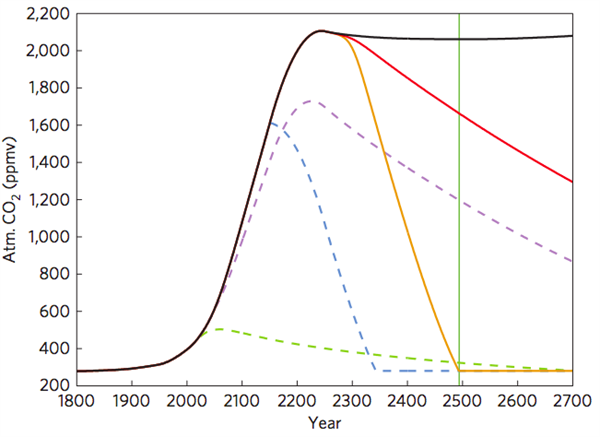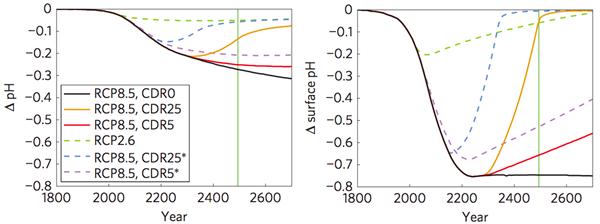
Geoengineering is no substitute for cutting emissions, new studies show
Robert McSweeney
08.04.15Robert McSweeney
04.08.2015 | 4:30pmAttempts to limit climate change by removing carbon dioxide directly from the atmosphere would not prevent the irreversible damage to the oceans, according to a new study.
While a second study finds that brightening clouds to reflect more of the Sun’s radiation could help boost crop yields in parts of China and Africa.
Speaking to Carbon Brief, authors from both studies highlight the importance of reducing carbon emissions now, rather than trying to engineer the climate later.
Geoengineering
Geoengineering is the deliberate large-scale intervention into the Earth’s climate system to try and limit human-caused climate change, and it can be divided into two main methods.
Removing carbon dioxide from the atmosphere, often described as Carbon Dioxide Removal (CDR), is one approach. The other is reflecting some sunlight away from the Earth before it can be trapped by greenhouse gases, commonly known as Solar Radiation Management (SRM).
The two new studies explore the implications of each of these methods, and the results are decidedly mixed.
Ocean acidification
We start with the oceans. About a quarter of the carbon dioxide emitted by human activity is taken up by the world’s oceans. There it reacts with water to form carbonic acid, reducing the pH level and making the oceans less alkaline.
This process is known as ocean acidification, and it can have serious implications for marine life, says Sabine Mathesius from the Helmholtz Centre for Ocean Research in Kiel in Germany. She explains to Carbon Brief:
“The resulting increase in the ocean’s acidity disturbs important biological processes, like the build-up of calcium carbonate shells. If ocean acidification continues at the current rate, many species at the bottom of the food chain, as well as corals, could face extinction. In consequence, species that depend on them, including fish and ultimately humans, would be affected too.”
Mathesius is the lead author of a study, published in Nature Climate Change, which investigates whether CDR could help stave off ocean acidification. Her results suggest that continuing to emit carbon dioxide in the hope of being able to remove it from the atmosphere later could consign our oceans to changes that are irreversible on human timescales.
Carbon dioxide removal
The study focuses on two scenarios, or representative concentration pathways, for how we deal with rising carbon emissions.
RCP8.5 is the highest of the emissions scenarios used by the Intergovernmental Panel on Climate Change (IPCC), and is described in this paper as “business-as-usual”. While RCP2.6 is the lowest IPCC scenario, where emissions are curbed to keep global average temperature rise to within 2C above pre-industrial levels.
The researchers simulated applying three different levels of CDR to the RCP8.5 high emissions scenario: none (“CDR0”), five billion tonnes per year (“CDR5”) and 25bn tonnes per year (“CDR25”).
The paper notes that CDR25 is “probably unfeasible” as it is way beyond the potential of technologies that currently exist. Even CDR5 would required “gigantic efforts”, but is technically possible, says Mathesius. Five billion tonnes of carbon is equivalent to 18.3bn tonnes of carbon dioxide – around half of global annual emissions in the present day.
The chart below shows what happens to total atmospheric carbon dioxide concentrations if these scenarios were played out over the centuries ahead. Only using CDR25 (orange and dashed blue lines) does carbon dioxide levels return to anything close to the RCP2.6 low emissions scenario (green dashed line), but not for at least two centuries.
Projections out to year 2700 of global atmospheric carbon dioxide concentrations under RCP8.5 with no CDR (black line), CDR5 from 2250 (red), CDR25 from 2250 (orange), CDR5 from 2050 (purple dashed), and CDR25 from 2150 (blue dashed). RCP2.6 shown as a green dashed line.
Irreversible changes
The charts below show what these scenarios of carbon emissions and CDR could mean for ocean acidification. The pH of the oceans drops in all scenarios, but recovers most quickly in the RCP2.6 scenario and the “unfeasible” CDR25 option.
Change in globally-averaged pH for the entire ocean (left-hand chart) and surface ocean (right-hand chart). Legend matches earlier chart. Source: Mathesius et al. (2015)
Acidification occurs first in the surface waters and then spreads to the rest of the ocean over time, explains Mathesius:
“The fastest alterations occur at the surface, where the ocean is directly exposed to the rising carbon dioxide concentration and increasing temperature of the atmosphere. Within decades to centuries, these altered water masses are transported by the large-scale ocean circulation into great depths.”
When and if atmospheric carbon dioxide levels do fall, the oceans eventually release the gas back into the atmosphere, says Mathesius. But the vast conveyor belt of the oceans means it would take much longer for the oceans to recover as well, she says:
“Once in the deep ocean, the acidified water is not in touch with the atmosphere anymore. Even if we could re-establish the atmospheric carbon dioxide concentration, the deep ocean would remain acidified for many centuries.”
This would be too late for the marine species that would have long become extinct, she adds.
So while CDR could potentially help reduce net carbon emissions, it should only be in combination with ambitious climate policy, concludes Mathesius:
“Our study shows that CDR has the ability to reduce atmospheric carbon dioxide and its impacts for the oceans to some extent – but not nearly enough to counteract the impacts of a business-as-usual emissions scenario.”
Marine cloud brightening
The second study, published in Environmental Research Letters, considers how SRM over the oceans could boost crops yields and reduce harvest failures in northeastern China and West Africa.
Marine cloud brightening (MCB) is potentially a way of “seeding” clouds to reduce incoming solar radiation in the tropics, says lead author Dr Ben Parkes, formerly of the Climate Impacts Group at the University of Leeds, and now at the University of Pierre and Marie Curie in Paris. He explains to Carbon Brief.
“By increasing the cloud droplet number in the clouds, they become brighter and reflect away more incoming solar radiation.”
Parkes and his colleagues ran simulations of a “very mild form” of climate change where carbon emissions rise by 1% a year until atmospheric concentrations reach double pre-industrial levels (560 parts per million, ppm). They then added in a simulation where clouds over 3.3% of the world’s ocean were brightened – predominantly over the Pacific and South Atlantic.
Using a crop model they compared how well spring wheat in China and groundnuts in West Africa would grow under these scenarios when compared to a third “control” scenario that holds atmospheric carbon dioxide at 440ppm.
The results show crop yields are higher under the climate change scenario, and greater still with MCB implemented. The yields increase as a result of lower temperatures, increased rainfall and the boost to crop growth caused by higher levels of carbon dioxide in the air, says Parkes.
The study found mixed impacts on the number of crop failures. Under climate change, the number of failures in groundnut crops in West Africa were lower than the control scenario, and were reduced further with MCB. For spring wheat in China, crop failures under climate change were higher than the control, though MCB scenarios tempered this increase. Generally, MCB was more effective at reducing “mild” crop failures than “severe” ones, the study finds.
Parkes also notes that although geoengineering could bring some benefit to these regions, the impacts may differ elsewhere:
“MCB changes the precipitation rates globally and in regions of reduced precipitation – notably the Amazon but also South East Asia – we would expect an increase in crop failures. This is something that would require further investigation.”
Fields of wheat in China. Credit: ssguy | Shutterstock
Treating the symptoms, not the illness
Brightening clouds over the oceans can only be a temporary way of offsetting the impacts of climate change, warns Parkes:
“MCB doesn’t undo climate change but instead mitigates some of the effects; in a medical metaphor, it treats the symptoms not the illness.”
And if climate change is more severe than the mild scenario they tested, geoengineering efforts would be less effective in preventing crop failures, Parkes adds:
“If [the increase in emissions] were to continue, they would eventually have a greater warming effect than the cooling effect from the geoengineering. This is why all solar radiation management schemes are a temporary solution while a transfer to a lower emission economy takes place.”
This is a conclusion shared by Dr Richard Matear and Dr Andrew Lenton from the Commonwealth Scientific and Industrial Research Organisation (CSIRO) in Australia. Writing in an accompanying News & Views article to the CDR paper, they say that cutting emissions now is a much safer option than relying on geoengineering:
“[The research] demonstrates that proposed technological solutions, like CDR, to the problems of global warming and ocean acidification are no substitute for reducing carbon emissions, which remains the safest and most reliable path for avoiding dangerous climate change.”
Main image: A Vattenfall employee works at the carbon dioxide capture and storage facility in Schwarze Pumpe, Brandenburg.
Matear, R. & Lenton, A. (2015) Restoration of the oceans, Nature Climate Change, doi:10.1038/nclimate2737; Mathesius, S. et al. (2015) Long-term response of oceans to carbon dioxide removal from the atmosphere, Nature Climate Change, doi:10.1038/nclimate2729 & Parkes, B. et al. (2015) Crop failure rates in a geoengineered climate: impact of climate change and marine cloud brightening, Environmental Research Letters, doi:10.1088/1748-9326/10/8/084003
-
Attempts to limit climate change by removing carbon dioxide directly from the atmosphere would not prevent the irreversible damage to the oceans
-
Study finds that brightening clouds to reflect more of the Sun's radiation could help boost crop yields in parts of China and Africa




